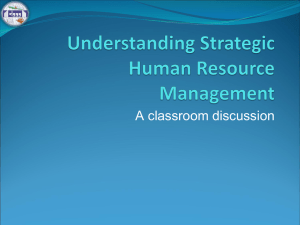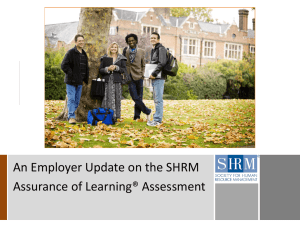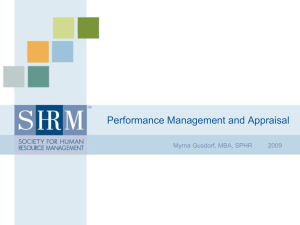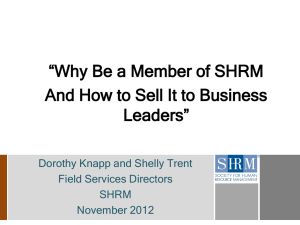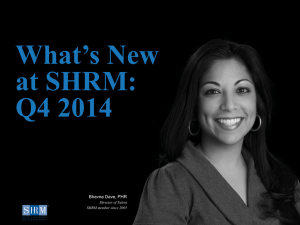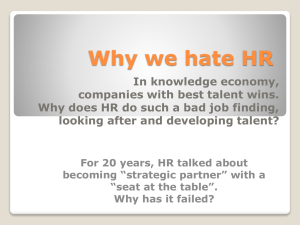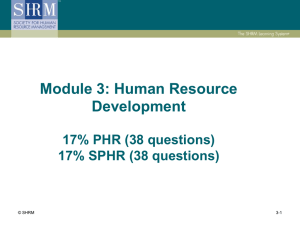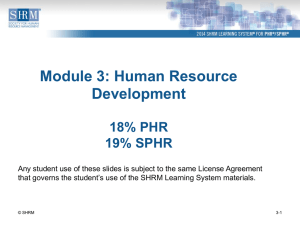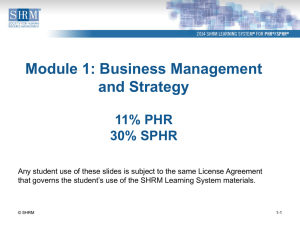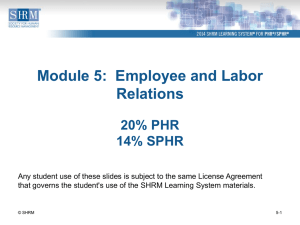Module PowerPoint 3b
advertisement
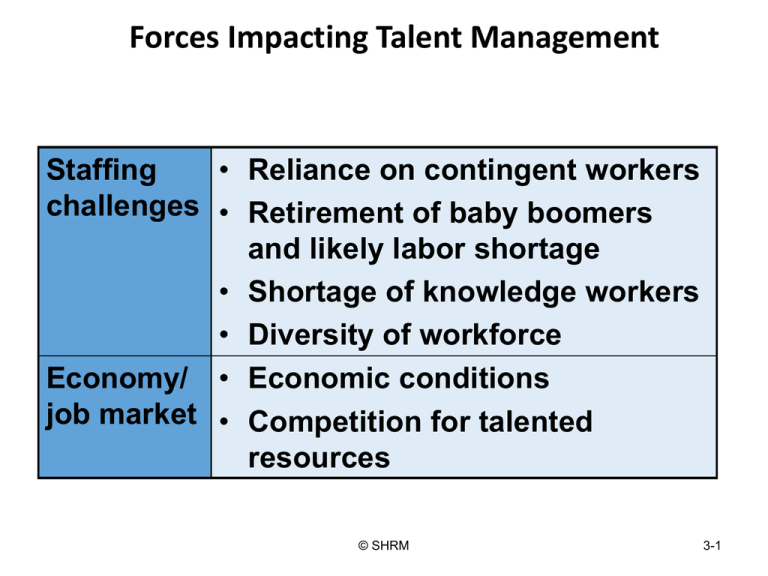
Forces Impacting Talent Management Staffing • Reliance on contingent workers challenges • Retirement of baby boomers and likely labor shortage • Shortage of knowledge workers • Diversity of workforce Economy/ • Economic conditions job market • Competition for talented resources © SHRM 3-1 Orientation and Onboarding Programs • Orientation provides initial exposure to: – Organizational information. – Policies, procedures, and benefits. – Work context. • Onboarding promotes assimilation into: – Organizational culture and norms. – Specific departments and functions. – Support systems (e.g., mentoring, work/life balance). © SHRM 3-2 Career Development Career management: Organizational focus Career planning: Individual focus Career development occurs when the needs of the organization and the individual coincide. © SHRM 3-3 Model for Career Development Late career Mid career Early career establishment and achievement Organizational entry Occupational preparation © SHRM 3-4 Career Development Programs • Employee self-assessment • Individual coaching/counseling • Employee development programs – Apprenticeship and continuing education – Committee participation – Job rotation, enlargement, and enrichment © SHRM 3-5 A mid-level manager might regularly meet with a senior executive during which career development option? A. Mentoring B. Fast track C. Job enrichment D. Expatriation/repatriation Answer: A © SHRM 3-6 Dual Career Ladders Identify meaningful career paths for people who are not interested in traditional management roles. Level 5 Chief Information Officer Level 5 Senior Technical Specialist Level 4 Director Level 4 Technical Specialist Level 3 Department Head Level 3 Technical Lead Level 2 Senior Information Systems Specialist Level 1 Information Systems Specialist © SHRM 3-7 Succession and Replacement Planning Succession Replacement • Long-term; 12-36 months. • Focuses on leadership talent for the future. • Develops leaders capable of filling multiple assignments. • Short-term; 0-12 months. • Focuses on immediate needs. • Develops backup staff for key positions. Fast-track programs speed the development of potential leaders. © SHRM 3-8 Employee Needs SPHR only • Flexible staffing – – – – • Expatriation – Sending employees abroad and supporting their ability to succeed. Flextime/telecommuting. Compressed workweek. Job sharing. Phased retirement. • Repatriation – Reintegrating employees into their home country. • Diversity – Training facilitates communication and productivity among all employees. © SHRM 3-9 Leadership and Management • Leadership requires alignment to the organization’s vision and mission. – Leaders influence others toward the achievement of goals, act as change agents, serve by example, and develop other leaders. • Management is about coping with day-to-day operations. – Brings order and consistency to the organization. – Establishes systems and structures that get results. © SHRM 3-10 Which responsibility is MOST characteristic of a leader? A. Evaluating recommendations from a corporate communications survey B. Implementing a corporate ethics program C. Reviewing and adjusting sales forecasts D. Establishing a vision for the organization Answer: D © SHRM 3-11 Behavioral Dimensions of Leadership Consideration (employeecentered) • Behavior aimed at meeting the social and emotional needs of groups and individuals. • Helping group members and explaining decisions. Initiating structure (joboriented) • Behavior aimed at careful supervision of work methods and performance levels. • Clarifying roles and setting goals. © SHRM 3-12 Blake-Mouton’s Theory Managerial Grid A great deal 9 Country club manager Concern for People Team leader Middle-of-theroad manager Impoverished manager Authoritarian manager 1 Very little 9 A great deal Concern for Production (Task) © SHRM 3-13 Hersey-Blanchard’s Theory Leadership styles match the situation. High Selling Participating Share ideas and facilitate in Relationship decision making Behavior (Supportive Behavior) Low Relationship/ Low Task Delegating Low © SHRM High Relationship/ Low Task Turn over responsibility for decisions and implementation High Task/ High Relationship Provide specific instructions; closely supervise performance Task Behavior (Guidance) 3-14 Explain decisions and provide opportunity for clarification High Task/ Low Relationship Telling High Fiedler’s Contingency Theory • Favorableness of the leadership environment is determined by three factors: – Leader-member relations: The degree of trust that followers have in their leaders. – Task structure: The extent to which tasks are defined. – Position power: The degree of power and influence a leader has over subordinates. • Leaders should change the factors rather than changing their style. © SHRM 3-15 Leadership Styles • Transactional: • Transformational: – Offers promise of reward or threat of discipline. – Looks for deviation from rules. – Intervenes when standards are not met. – Abdicates responsibility and avoids making decisions. © SHRM – Provides vision and sense of mission. – Communicates high expectations. – Promotes intelligence and problem solving. – Gives personal attention and coaches. 3-16 Emotional Intelligence • Ability to be sensitive to and understand emotions of others and to manage own emotions • Four branches: – – – – Perceiving emotion Using emotion to facilitate thought Understanding emotion Regulating emotion • Positive correlation between leadership effectiveness and emotional intelligence quotient (EQ) © SHRM 3-17 Performance Management System Drives business results that accomplish the goals of the organization. Organizational values and goals Performance management standards Employee performance/behaviors Measurement and feedback Business results and employee growth © SHRM 3-18 Fostering a High-Performance Workplace Organizations must provide: • Executive support. • Challenging work environment. • Employee engagement activities. • Performance management training. © SHRM • Continual feedback. • Resources and tools. • Consistent management practices. 3-19 Individual Performance Appraisals 1. Observe employee performing the job. 2. Identify and record strengths and areas for improvement. 5. Set goals for performance improvement. 4. Provide reinforcing and corrective feedback on employee performance. 3. Rate employee on progress toward previously stated objectives. © SHRM 3-20 Appraisal Methods • Category rating methods • Narrative methods – Simple marking of performance level – Graphic scale, checklist, forced choice – Written narrative appraisals – Essay, critical incidents, field review • Comparative methods • Special methods – Compare performance of employees – Ranking, paired comparison, forced distribution – Designed to overcome appraisal difficulties – MBO, BARS © SHRM 3-21 Which appraisal method is best exemplified by the following? Low 1 2 3 Quality A. B. C. D. BARS Forced distribution Graphic scale Ranking Answer: C © SHRM 3-22 4 5 High Errors in Performance Appraisal Halo/horn Contrast Central tendency Recency Errors Leniency Primacy Bias Strictness © SHRM 3-23 Legal Performance Appraisals • Performance appraisal methods must be: – Valid and free of discrimination. – Based on formal evaluation criteria. – Based on personal knowledge of and interaction with employees. – Designed to prevent one manager from overinfluencing an employee’s career. – Based on equitable treatment of all employees. © SHRM 3-24 Appraisal Feedback Guidelines • • • • Describe the behavior; don’t judge it. Assume an attitude of helpfulness. Empathize and listen actively. Give specific examples. © SHRM 3-25 Documentation Guidelines • • • • Document as situations happen. Keep notes on all employees, not just a few. Use objective criteria. Support job-related observations with facts, but avoid conclusions. • Focus on deficiencies, not causes. • Remember that others may read your comments. © SHRM 3-26
